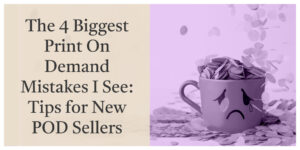Knowing the common print on demand mistakes is really important if you want to build a successful business.
I’ve been working with print-on-demand for a long time now, have a ton of experience with running a successful fulfillment center, and have had over 1,000 people post about their first sale in our Low Hanging System facebook group.
And because I know what works and what doesn’t with print-on-demand, and I wanted to share that information with you so that you too can ideally make sales and live the life you’ve always wanted.
Below, I go over the four biggest print on demand mistakes I see people make and what to do instead.
Let’s take a look…
Mistake #1: Making Designs Too Fancy
One of the most common print on demand mistakes new sellers make is overcomplicating their designs. A prevailing misconception is that elaborate designs sell better. But this isn’t true. In reality, simple is better.
Why simple sells:
- Wide Appeal: Complex designs can alienate potential customers. Every added element—from several fonts to intricate images—increases the risk of someone not resonating with your product.
- Ease of Consumption: Many shoppers browse on their phones, where designs must be instantly understandable. A cluttered design can deter purchases simply because it’s hard to read.
Examples from Top Sellers
Whether on Amazon or Etsy, the best-selling print-on-demand products often follow a minimalist approach.
- Amazon: Novelty mugs featuring straightforward text dominate the bestseller lists. These designs are clean and use only basic elements like text and simple icons.
- Etsy: While Etsy tends to favor images more than Amazon, text-heavy designs still prevail among the top sellers. This shows that even in a visually oriented marketplace, simple is best.
Practical Advice for Beginners
If you’re just starting with print-on-demand, here are a few actionable tips:
- Start Simple: Stick to black text on a white background. Focus on witty or meaningful phrases that resonate with your target audience.
- Test and Adapt: Once you have success with a basic design, you can experiment cautiously with extra elements like images or varied fonts.
- Consider User Experience: Ensure your design is clear and easily visible, even on mobile devices. This improves the likelihood of conversions.
The Image Dilemma
Images can indeed enhance a design, but they come with challenges. For instance, a specific detail—like the color of a dog’s eyes—can deter potential buyers if it doesn’t match their expectations.
Simplicity with your designs isn’t just a suggestion. It’s a strategy backed by data and experience in the print-on-demand industry. Starting with minimalist designs reduces the barriers to purchase and increases the likelihood of finding a winning product.
Remember, the goal is to build momentum and revenue early on. Once you establish a successful pattern with simple designs, you’ll have the confidence and resources to expand creatively.
Mistake #2: Being Overly Innovative with Designs
Innovation is often celebrated. But it can sometimes lead you astray from what works in the print-on-demand marketplace.
Part 1: Straying from the Low-Hanging Model
When I refer to the “low-hanging model,” I’m emphasizing a strategy that targets specific niches and markets. The Low Hanging System focuses on identifying niche-specific keywords that potential buyers are actively searching for. Whether it’s “funny mug for dad” or “gift for cat lovers,” these keywords represent entry points into established markets.
The Problem with Overly Creative Designs
A common mistake sellers make is developing products based on phrases or themes that are personally amusing but lack buyer demand. For instance, inspirational quotes are wonderful. However, if nobody searches for them, they won’t sell well on platforms like Etsy or Amazon where organic search drives visibility.
Why Stick to What Works?
1. Leveraging Established Traffic: Platforms like Etsy and Amazon have invested heavily in attracting and retaining customers. By aligning your products with what people are actively searching for, you tap into this existing traffic without needing costly advertising.
2. Long-Tail Niches: Instead of competing in saturated, broad markets, target long-tail niches. These are specific, less competitive markets where your products can stand out and achieve higher search engine rankings.
Practical Advice for Success
If you’re serious about succeeding with print-on-demand, here are actionable steps to consider:
1. Use Keyword Research: Leverage tools or methods to identify niche-specific keywords that align with buyer intent. This ensures your products are visible to those actively seeking them.
2. Focus on Specificity: Craft your designs around specific themes or interests, such as hobbies, professions, or specific relationships (e.g., coworker gifts, cat lovers).
3. Balance Innovation with Strategy: While creativity is essential, ensure that most of your designs cater directly to established market demands. Reserve a portion of your time for innovative projects, but prioritize proven strategies for consistent sales.
Examples of Effective Designs
- Funny Mug for Coworker: Designs featuring phrases like “None of your emails are finding me well. Thoughts during work.” resonate directly with the intended audience—coworkers who appreciate humor related to office life.
- Gifts for Specific Relationships: Whether it’s a mug for a dad or a t-shirt for a cat lover, specificity in design ensures that your products meet the exact needs and expectations of potential buyers.
Success in print-on-demand often hinges on aligning your designs with what customers are actively searching for. By adhering to proven strategies and targeting niche-specific markets, you increase your chances of generating consistent sales and building a sustainable business.
Mistake #3: Not Exploring Enough Niches
Another one of the most critical print on demand mistakes many new sellers make is not exploring a variety of niches. But doing so is important because simply creating generic products aimed at broad audiences often leads to lackluster results. Here’s why focusing on multiple niches can transform your print-on-demand success.
The Problem with Generalization
Imagine visiting a store where every product caters to a general theme, like “nursing” or “dogs.” Themes are broad and relatable. But they often fail to stand out amidst intense competition. Products like “funny mugs” or “inspirational candles” flood the market, making it exceedingly difficult for new entries to gain traction.
Embrace Obscure Niches
Instead of competing in overcrowded spaces, try exploring obscure or specific niches. For instance, rather than targeting “dog lovers,” consider creating designs specifically for “black and tan Coonhound enthusiasts” or “bearded collie owners.” These niches may have fewer competitors, allowing your products to attract a more dedicated audience.
Testing and Diversification
The key to finding successful niches lies in testing and diversification. Don’t limit yourself to a handful of designs within a single niche. Spread your efforts across various niches and see what resonates. Think of it as throwing spaghetti at the wall—you’re experimenting to discover what sticks.
Leveraging Tools for Success
In the Low Hanging System, you’ll find tools like the Master List of Design Ideas and SpotNiches software, which streamlines niche discovery. These tools help you identify underserved markets where your products can fill a genuine need. Whether it’s a specific profession, hobby, or interest, these tools provide insights to capitalize on great niche opportunities.
Practical Examples and Strategies
Let’s break it down with a practical example: If you create products for nurses, rather than offering generic “nurse” designs, explore sub-niches such as “oncology nurse” or “ER nurse.” Each sub-niche represents a unique audience with specific preferences and buying behaviors, which can increase your chances of making sales.
Simplifying Your Approach
Creating products for various niches doesn’t mean reinventing the wheel for each design. Use formulas and templates provided by the Low Hanging System to streamline your creative process. Additionally, a tool like Pixplosion further simplifies the design creation process. That way, you can focus on exploring new niches rather than getting bogged down in design details.
If you’re serious about succeeding with print-on-demand, focus on niche exploration and diversification. Avoid the trap of generalized products and instead target specific niches. That way, you position yourself for greater visibility and sales success.
Mistake #4: Not Using Keywords in Titles
You must optimize your product titles. Your title is your product’s first impression on platforms like Etsy and Amazon. It signals to potential buyers exactly what your product is about.
The Power of the First Three Words
The first three words of your Etsy title are gold. They are the most crucial for catching the attention of both customers and search algorithms. Just think about it—when someone searches for a specific item, they’re likely to use precise terms like “funny Rottweiler mug” or “gift for oncology nurse.” By starting your title with these targeted keywords, you’re directly telling Etsy and Amazon who your product is for.
Examples of Effective Titles
Let’s break it down with an example. If you’re selling a mug designed for Pitbull lovers, your title should ideally start with “Pitbull mug” or “Funny Pitbull mug.” Why? Because these are the terms that potential buyers are typing into the search bar. Etsy rewards products that match closely with what customers are searching for. So starting with these keywords increases the chances of your products being seen and bought.
Avoiding Common Print On Demand Mistakes
Another mistake is using generic terms or burying relevant keywords deep in the title. For instance, instead of “Gift for plovers,” opt for “Pitbull mug” as your primary title. Then, include “gift” or other descriptors later on. This ensures clarity and increases the likelihood of your product showing up in relevant searches.
The Role of Specificity
Specificity is your friend in the world of print-on-demand. If someone searches for “Pitbull gift,” they might have varied intentions. Maybe they’re looking for a collar or artwork, not necessarily a mug. By focusing on “Pitbull mug,” you’re directly addressing the customer’s intent, making it more likely they’ll click and buy your product.
Simplifying Your Approach
You don’t need fancy software to create effective titles. Use common sense and consider what your ideal customer would type into the search bar. For example, if you’re selling a mug for basket weavers, a straightforward title like “Basket Weaving Mug – Coffee Cup for Basket Weavers.” It covers all the bases while ensuring the most relevant keywords are front-loaded.
Your Etsy title is your gateway to attracting customers. Using specific keywords and starting strong with the most relevant terms improves your visibility and sales potential. Remember, Etsy and Amazon reward products that match customer intent. So make it easy for customers to find and choose your products.
Ready to elevate your print-on-demand business to new heights? The Low Hanging System offers in-depth guidance, community support, and access to a treasure trove of resources. It accelerates your journey from novice to thriving POD entrepreneur.
YES! I want to learn more.
I hope you find this post about print on demand mistakes useful. If you’ve been wondering “Is it hard to make money with print-on-demand?” The answer is no, not if you do it right. If you have any other insights you’d like to add, please leave a comment below. And if you enjoyed this post, please consider sharing it with your friends and followers.





3 thoughts on “The 4 Biggest Print On Demand Mistakes I See: Tips for New POD Sellers”
Thank you for the refresher all in one great post!
Hi. When I were looking at these videos on this email, I saw the mugs are very low marked ($11 – $19). With the LHS that I purchased more than a year ago, in Gearbubble the mugs are way to expensive to sell a mug for less than $25 . I can’t compete with these low prices. Where do I find mugs and t-shirts to do print on demand for these low prices?
Hey there, Please email rachelreports@gmail.com. Thanks!